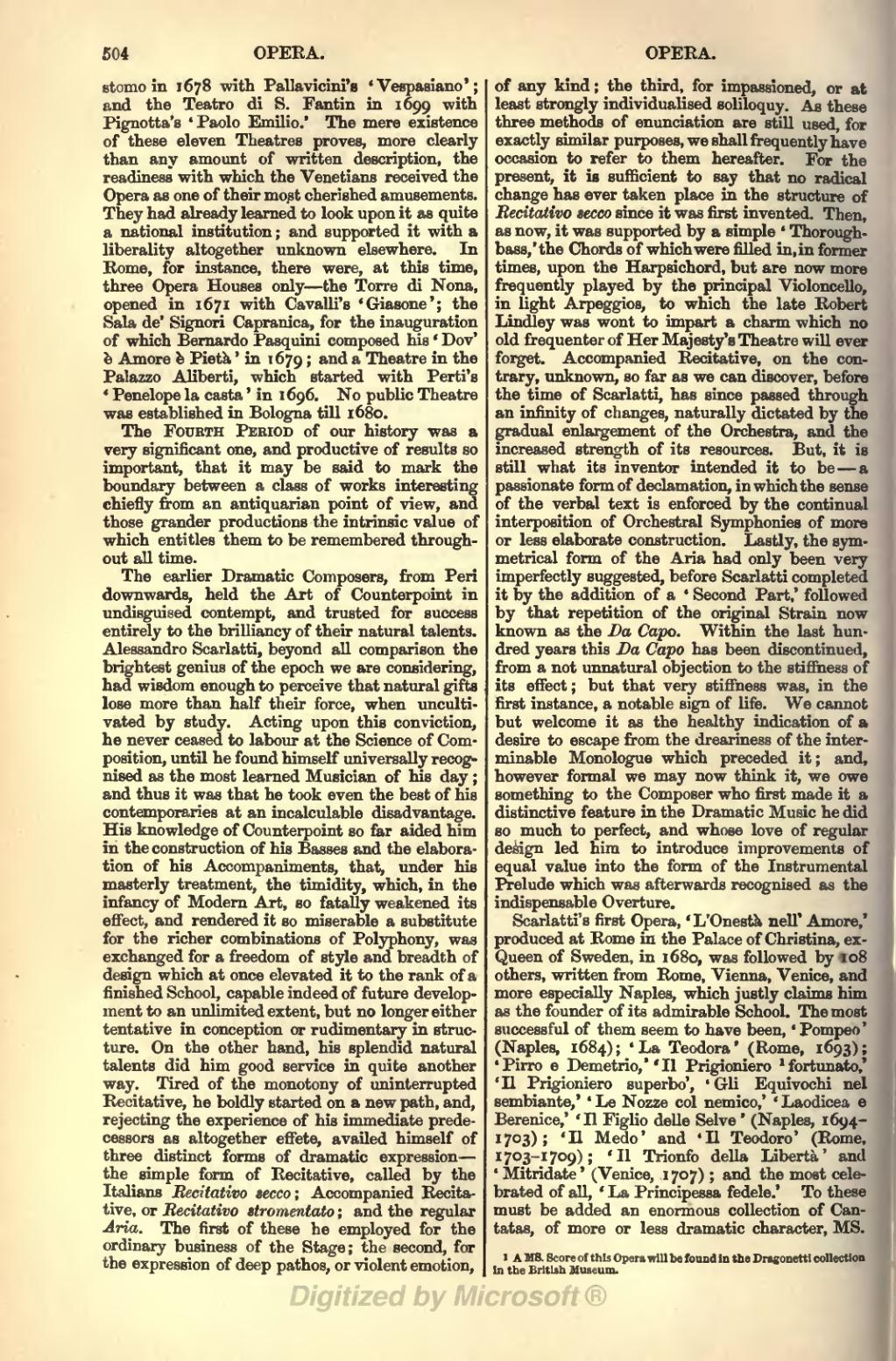stomo in 1678 with Pallavicini's 'Vespasiano'; and the Teatro di S. Fantin in 1699 with Pignotta's 'Paolo Emilio.' The mere existence of these eleven Theatres proves, more clearly than any amount of written description, the readiness with which the Venetians received the Opera as one of their most cherished amusements. They had already learned to look upon it as quite a national institution; and supported it with a liberality altogether unknown elsewhere. In Rome, for instance, there were, at this time, three Opera Houses only—the Torre di Nona, opened in 1671 with Cavalli's 'Giasone'; the Sala de' Signori Capranica, for the inauguration of which Bernardo Pasquini composed his 'Dov' e Amore e Pieta 'in 1679; and a Theatre in the Palazzo Aliberti, which started with Perti's 'Penelope la casta' in 1696. No public Theatre was established in Bologna till 1680.
The Fourth Period of our history was a very significant one, and productive of results so important, that it may be said to mark the boundary between a class of works interesting chiefly from an antiquarian point of view, and those grander productions the intrinsic value of which entitles them to be remembered throughout all time.
The earlier Dramatic Composers, from Peri downwards, held the Art of Counterpoint in undisguised contempt, and trusted for success entirely to the brilliancy of their natural talents. Alessandro Scarlatti, beyond all comparison the brightest genius of the epoch we are considering, had wisdom enough to perceive that natural gifts lose more than half their force, when uncultivated by study. Acting upon this conviction, he never ceased to labour at the Science of Composition, until he found himself universally recognised as the most learned Musician of his day; and thus it was that he took even the best of his contemporaries at an incalculable disadvantage. His knowledge of Counterpoint so far aided him in the construction of his Basses and the elaboration of his Accompaniments, that, under his masterly treatment, the timidity, which, in the infancy of Modern Art, so fatally weakened its effect, and rendered it so miserable a substitute for the richer combinations of Polyphony, was exchanged for a freedom of style and breadth of design which at once elevated it to the rank of a finished School, capable indeed of future development to an unlimited extent, but no longer either tentative in conception or rudimentary in structure. On the other hand, his splendid natural talents did him good service in quite another way. Tired of the monotony of uninterrupted Recitative, he boldly started on a new path, and, rejecting the experience of his immediate predecessors as altogether effete, availed himself of three distinct forms of dramatic expression—the simple form of Recitative, called by the Italians Recitative secco; Accompanied Recitative, or Recitative stromentato; and the regular Aria. The first of these he employed for the ordinary business of the Stage; the second, for the expression of deep pathos, or violent emotion, of any kind; the third, for impassioned, or at least strongly individualised soliloquy. As these three methods of enunciation are still used, for exactly similar purposes, we shall frequently have occasion to refer to them hereafter. For the present, it is sufficient to say that no radical change has ever taken place in the structure of Recitativo secco since it was first invented. Then, as now, it was supported by a simple 'Thoroughbass,' the Chords of which were filled in, in former times, upon the Harpsichord, but are now more frequently played by the principal Violoncello, in light Arpeggios, to which the late Robert Lindley was wont to impart a charm which no old frequenter of Her Majesty's Theatre will ever forget. Accompanied Recitative, on the contrary, unknown, so far as we can discover, before the time of Scarlatti, has since passed through an infinity of changes, naturally dictated by the gradual enlargement of the Orchestra, and the increased strength of its resources. But, it is still what its inventor intended it to be—a passionate form of declamation, in which the sense of the verbal text is enforced by the continual interposition of Orchestral Symphonies of more or less elaborate construction. Lastly, the symmetrical form of the Aria had only been very imperfectly suggested, before Scarlatti completed it by the addition of a 'Second Part,' followed by that repetition of the original Strain now known as the Da Capo. Within the last hundred years this Da Capo has been discontinued, from a not unnatural objection to the stiffness of its effect; but that very stiffness was, in the first instance, a notable sign of life. We cannot but welcome it as the healthy indication of a desire to escape from the dreariness of the interminable Monologue which preceded it; and, however formal we may now think it, we owe something to the Composer who first made it a distinctive feature in the Dramatic Music he did so much to perfect, and whose love of regular design led him to introduce improvements of equal value into the form of the Instrumental Prelude which was afterwards recognised as the indispensable Overture.
Scarlatti's first Opera, 'L'Onestà nell' Amore,' produced at Rome in the Palace of Christina, ex-Queen of Sweden, in 1680, was followed by 108 others, written from Rome, Vienna, Venice, and more especially Naples, which justly claims him as the founder of its admirable School. The most successful of them seem to have been, 'Pompeo' (Naples, 1684); 'La Teodora' (Rome, 1693); 'Pirro e Demetrio,' 'Il Prigioniero [1]fortunato,' 'Il Prigioniero superbo', 'Gli Equivochi sembiante,' 'Le Nozze col nemico,' 'Laodicea Berenice,' 'Il Figlio delle Selve' (Naples, 1694–1703); 'Il Medo' and 'Il Teodoro' (Rome, 1703–1709); 'Il Trionfo della Libertà' and 'Mitridate' (Venice, 1707); and the most celebrated of all, 'La Principessa fedele.' To these must be added an enormous collection of Cantatas, of more or less dramatic character, MS.
- ↑ A MS. Score of this Opera will be found in the Dragonetti collection in the British Museum.
